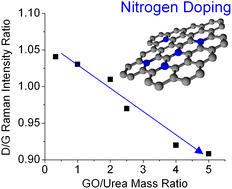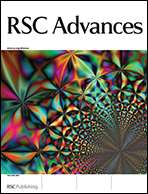Insitu Raman spectroscopy and thermal analysis of the formation of nitrogen-doped graphene from urea and graphite oxide†
Abstract
A comprehensive in situ analysis of the formation of graphene during the thermal exfoliation via reduction expansion synthesis (RES) of graphite oxide (GO) in the presence of urea is presented. The addition of urea expedites the exfoliation and reduction process while introducing nitrogen (N) impurities, which serve as dopants within the graphene lattice. The aim of this study is to provide deeper insight into the physical and chemical processes that take place during the synthesis and to gain better understanding of the effect of urea on the reduction, thermal exfoliation and doping of GO. In situ Raman spectroscopy was employed to shed light on the structural changes that occurred during the GO–graphene transformation in the temperature range 25–800 °C. Thermogravimetric analysis, differential scanning calorimetry, and mass spectroscopy, were used as complementary techniques to monitor sample weight, reaction heat, and gas evolution, in order to distinguish between the various chemical reactions. Finally, the above characterization methods were utilized to gather information about the thermal stability and reactivity of the N-doped graphene by exposing the synthesized sample to additional heating–cooling cycles, after the initial transformation was completed.


 Please wait while we load your content...
Please wait while we load your content...